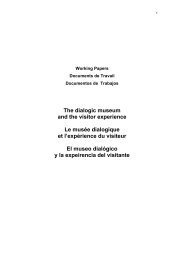1. Statement of principles of museum documenta - The International ...
1. Statement of principles of museum documenta - The International ...
1. Statement of principles of museum documenta - The International ...
You also want an ePaper? Increase the reach of your titles
YUMPU automatically turns print PDFs into web optimized ePapers that Google loves.
3<br />
12. <strong>The</strong> <strong>documenta</strong>tion must include information about any intellectual property rights concerning<br />
the object. In order to respect these rights, the <strong>museum</strong> should document the owners<br />
<strong>of</strong> any associated intellectual property rights, and monitor any transfer <strong>of</strong> these rights.<br />
13. <strong>The</strong> system should incorporate the results <strong>of</strong> research and other published material<br />
about the object or references to such information, such as exhibition catalogue entries. If<br />
the object is cited in published material, the author should refer to the unique number <strong>of</strong> the<br />
object.<br />
14. If the existing collection is inadequately documented, the <strong>museum</strong> should implement a<br />
programme to upgrade the <strong>documenta</strong>tion by an agreed deadline. <strong>The</strong> sources for this information<br />
may include a physical stocktaking and a review <strong>of</strong> any original registers and files.<br />
<strong>The</strong> first priority should be to establish a baseline inventory <strong>of</strong> the collection, with primary<br />
information about each object, such as unique number, location, object name and condition.<br />
If objects are found without a number and the old number cannot be traced in the original<br />
<strong>documenta</strong>tion, they may need to be assigned a new number during this process.<br />
15. In addition to details about individual objects, the <strong>museum</strong> should develop information<br />
about themes and subjects <strong>of</strong> relevance to the collection. It should develop details about the<br />
people, organisations and cultures associated with the collection, such as donors, collectors,<br />
producers, and previous owners and users. If appropriate, it should also develop information<br />
about archaeological and natural history sites and their surrounding environments and<br />
archaeological processes (Code 3.3).<br />
16. <strong>The</strong> system should provide facilities which enable the collection information to be incorporated<br />
in resources such as education and interpretation material and online exhibitions<br />
and learning resources.<br />
17. <strong>The</strong> <strong>documenta</strong>tion system should provide procedural support for collections management,<br />
such as the steps to be followed and decisions to be taken when lending an object to<br />
another institution.<br />
18. <strong>The</strong> system should incorporate information about the outcome <strong>of</strong> each significant collections<br />
management activity affecting an object, such as conservation (Code 2.24), photography,<br />
loans-out and its use in exhibitions and displays.<br />
19. If an object is deaccessioned, its <strong>documenta</strong>tion should be retained by the <strong>museum</strong>. If<br />
the object is transferred to another <strong>museum</strong>, a copy <strong>of</strong> the <strong>documenta</strong>tion should be passed<br />
to that <strong>museum</strong>. Details <strong>of</strong> the basis on which an object was deaccessioned and the formal<br />
approval <strong>of</strong> this action must be added to the <strong>documenta</strong>tion about the object (Code<br />
2.12-2.17).<br />
<strong>1.</strong>2.6. Security, sustainability and preservation<br />
20. <strong>The</strong> system must include provisions for the security, sustainability and the long-term<br />
preservation <strong>of</strong> information, such as storing registers in a fire-pro<strong>of</strong> safe, storing paper files<br />
in an environmentally controlled archive, backing-up and restricting access to digital information<br />
and ensuring that digital information is transferred from superseded systems and file<br />
formats into current systems (Code <strong>1.</strong>6 and 2.20-2.22).<br />
<strong>1.</strong>3. References and sources<br />
<strong>1.</strong> Further information about collections <strong>documenta</strong>tion is available from the CIDOC<br />
Web site (http://cidoc.icom.<strong>museum</strong>).<br />
2. <strong>International</strong> Council <strong>of</strong> Museums (1996). Handbook <strong>of</strong> standards. Documenting African<br />
collections. Paris: ICOM. ISBN 92-9012-029-0. [English-French edition.]<br />
(http://icom.<strong>museum</strong>/afridoc/)<br />
3. <strong>International</strong> Council <strong>of</strong> Museums (1997). Handbook <strong>of</strong> standards. Documenting African<br />
collections. Paris: ICOM. ISBN 92-9012-639-6. [Arabic edition, ICOM-Tunis.]<br />
3



